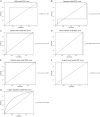Value of using blood routine indicators combined with artificial intelligence in sepsis patients
- PMID: 40385034
- PMCID: PMC12082538
- DOI: 10.62347/MMNQ1017
Value of using blood routine indicators combined with artificial intelligence in sepsis patients
Abstract
Objective: To explore the correlation between Blood Routine Indicators (BRI) and sepsis using machine learning algorithms (MLAs) and evaluate their application in early sepsis for prognosis assessment.
Methods: A total of 4,558 blood routine data (BRD) samples were collected, including 149 sepsis patients and 186 patients with common infections (CI). A binary logistic regression model (BLRM) was constructed to predict sepsis based on BRI. Additionally, MLAs were applied, including support vector machines, neural networks, Bayesian classifiers, k-nearest neighbors), decision trees, and random forest classification models (RFCM). The performance of these seven predictive models was evaluated.
Results: The RFCM demonstrated the best predictive performance among the MLAs, with accuracy of 86.97%, precision of 87.02%, recall of 86.97%, and F1 score of 0.87. These metrics were significantly higher than those of the BLRM (accuracy: 68.77%, precision PRE: 71.45%, recall: 69.47%, F1 Score: 0.70). In the random forest model, red blood cell volume distribution width (RDW) was identified as the most significant feature, with RDW-coefficient of variation contributing 6.98% and RDW-standard deviation contributing 5.32%.
Conclusion: Combining blood routine indicators (BRI) with MLA has considerable potential in predicting sepsis. The RFCM showed the highest predictive value, and RDW may play a crucial role in sepsis prediction.
Keywords: Sepsi; blood routine; machine learning algorithms; prediction.
AJTR Copyright © 2025.
Conflict of interest statement
None.
Figures



Similar articles
-
[Construction of a predictive model for in-hospital mortality of sepsis patients in intensive care unit based on machine learning].Zhonghua Wei Zhong Bing Ji Jiu Yi Xue. 2023 Jul;35(7):696-701. doi: 10.3760/cma.j.cn121430-20221219-01104. Zhonghua Wei Zhong Bing Ji Jiu Yi Xue. 2023. PMID: 37545445 Chinese.
-
Machine learning algorithms for diabetic kidney disease risk predictive model of Chinese patients with type 2 diabetes mellitus.Ren Fail. 2025 Dec;47(1):2486558. doi: 10.1080/0886022X.2025.2486558. Epub 2025 Apr 7. Ren Fail. 2025. PMID: 40195601 Free PMC article.
-
Comparison between traditional logistic regression and machine learning for predicting mortality in adult sepsis patients.Front Med (Lausanne). 2025 Jan 6;11:1496869. doi: 10.3389/fmed.2024.1496869. eCollection 2024. Front Med (Lausanne). 2025. PMID: 39835102 Free PMC article.
-
Artificial intelligence in clinical care amidst COVID-19 pandemic: A systematic review.Comput Struct Biotechnol J. 2021;19:2833-2850. doi: 10.1016/j.csbj.2021.05.010. Epub 2021 May 7. Comput Struct Biotechnol J. 2021. PMID: 34025952 Free PMC article. Review.
-
Evaluating Binary Classifiers for Cardiovascular Disease Prediction: Enhancing Early Diagnostic Capabilities.J Cardiovasc Dev Dis. 2024 Dec 9;11(12):396. doi: 10.3390/jcdd11120396. J Cardiovasc Dev Dis. 2024. PMID: 39728286 Free PMC article. Review.
References
-
- Hernandez G, Ospina-Tascón GA, Damiani LP, Estenssoro E, Hurtado J, Friedman G, Castro R, Alegría L, Teboul JL, Cecconi M, Ferri G, Jibaja M, Pairumani R, Fernández P, Barahona D, Granda-Luna V, Cavalcanti AB, Bakker J The ANDROMEDA SHOCK Investigators and the Latin America Intensive Care Network (LIVEN) Effect of a resuscitation strategy targeting peripheral perfusion status vs serum lactate levels on 28-day mortality among patients with septic shock: the ANDROMEDA-SHOCK Randomized Clinical Trial. JAMA. 2019;321:654–664. - PMC - PubMed
-
- Pittard MG, Huang SJ, McLean AS, Orde SR. Association of positive fluid balance and mortality in sepsis and septic shock in an Australian cohort. Anaesth Intensive Care. 2017;45:737–743. - PubMed
-
- Schwindenhammer V, Shiraishi A, Yamakawa K, Ogura H, Fujishima S. oXiris(R) use in septic shock: experience of two French centres. Blood Purif. 2019;47(Suppl 3):1–7. - PubMed
-
- Rhodes A, Evans LE, Alhazzani W, Levy MM, Ferrer R. Surviving sepsis campaign: international guidelines for management of sepsis and septic shock: 2016. Crit Care Med. 2017;45:486–552. - PubMed
LinkOut - more resources
Full Text Sources
